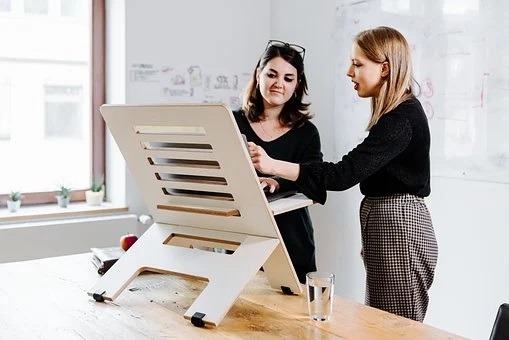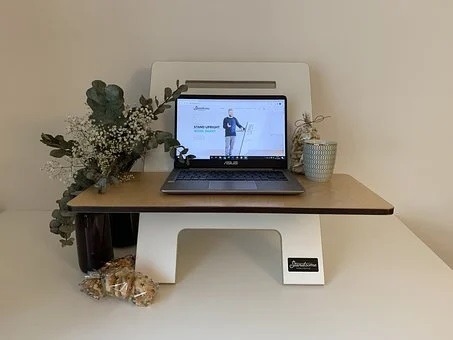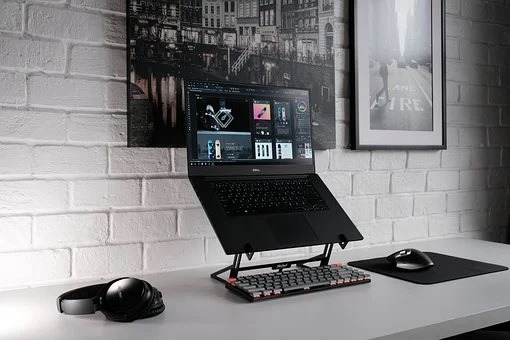A stand up desk, or standing desk, is a work surface that’s designed so that the user stands up while working on it. We can read, draw, type, code, or even write while standing. While it’s possible to sit at a standing desk by using a high stool, the main purpose of such furniture is to encourage standing while working.
We’re now aware that sitting for too long has an adverse effect on our health. Such habits lead to bad posture, back pain, joint issues, obesity, and much more. Standing, on the other hand, is said to offset many of these problems and might even help in boosting productivity. Let’s looking into standing desks in more detail now:
Are Standing Desks a New Idea?
Many people might think of standing desks as a new-fangled invention. Offices with modern layout and an innovative modest might offer such options, while the increase in people working from home has also led to many investing in stand up desks. However, such work surfaces are actually not a new idea.
In 1778, there was a sit and stand desk especially made for Marie Antoinette. Its purpose was to help her stay more comfortable while writing when she was pregnant. Not only this, but we now have evidence that many statesmen and writers stood while they were working. Just a few examples include Ernest Hemingway, Winston Churchill, Charles Dickens, Vladimir Nabokov, and Thomas Jefferson. Some of these used lecterns for their standing purposes, while others had desks especially made for them.
Types of Standing Desks
There are various designs and structures of standing desks available today, so we don’t have to restrict ourselves while choosing one. Some might want their desk to be especially used for a single kind of task; for instance, or placing a tablet on so they could watch or record videos while cooking.
Others might need a standing desk for architectural drafting, or for crafting. If you’d also like the option to sit, they do make desks with adjustable heights. The adjusting mechanism could be manual, with a hand crank, or use an electric motor. A sort of counterbalance system is also available with certain models.
For those who want a more portable option, there are some lectern-type designs. These can be set on any regular desk to convert it into a standing option. When you want to sit down, remove the lectern.
Many seated desks have a standardized height, but standing ones might have varying measurements. The heights could range from 28 to 50 inches, or be customized according to your needs. The ideal one for any user would be according to their height, especially if they have to move around while working on the surface.
Of course, the more you customize your standing desk, the more it’s going to cost. If you get one with a fixed height, it might coast around $100. However, sit-stand desks, especially those who have a power motor operated by a button, might cost upwards of a thousand dollars.
An advanced version of the stand-up desk is a treadmill desk. These are even pricier, but they can be really useful for getting some exercise in while working.
What Are the Health Benefits of Standing Desks?
If you’re on the fence about whether to get a standing desk or not, here are some health benefits to consider:
Burns More Calories
At least one study shows us that just standing while doing any job burns at least 88 calories per hour. Sitting burns 80 calories, while walking will burn off 210 calories per hour. The difference between sitting and standing might be very little, but this only means that we’re not expanding much more energy by standing rather than sitting.
One should also consider that it’s easier to keep moving around and walk a bit while you’re at a standing desk. When you’re ensconced in a chair, getting up for water, refreshments, or anything else might seem a bit difficult. When you’re working while standing, doing little errands or going out for a while becomes much easier. All of this can result in your being more active and burning more calories on a regular basis.
Less Risk of Back Pain
Back pain is a common complaint, even among younger people. This isn’t surprising, as constant sitting tightens your muscles and hurts our lower back. The time we spend hunched over a screen further leads to bad posture, but standing desks might help ease the pain.
At present, there’s no definitive answer on how long we should stand in order to benefit from the habit. However, it’s obvious that standing up straight while working long hours will help with our posture at least.
Increasing Productivity
Some people might have concerns that standings desks could hinder typing and similar daily tasks. In practise, though, it’s only a matter of time before one gets used to typing while standing up. Plus, there’s some evidence that standing improves our mood and boosts our energy levels too. With this positive effect, having a standing desk might boost our productivity whether we’re working at home or in an external workspace.
A Possible Life Span Increase
When we’re too used to sitting, our lifestyle becomes much more sedentary. There’s a strong correlation between sedentary habits and health problems like heart disease and type 2 diabetes.
Long sitting periods can also increase the chances of obesity, metabolic syndrome, high blood pressure, excess fat around the abdomen, abnormal levels of cholesterol, and high blood sugar levels. All of these are dangerous factors for our overall health.
An increased risk of these issues can lead to an earlier death, so it’s evident that we need to cut back on setting wherever possible. With a standing desk, we might be able to reduce sitting time by several hours a week.
Here are just a few more issues that come with standing too much.
Possible Drawbacks of Stand Up Desks
While standing desks have a lot of benefits, they’re not always perfect or the best option for everyone. Consider these possible issues before deciding on getting one for yourself or your office:
Pain in the Legs and Feet
When we stand for too long, it could place a lot of pressure on our feet, hips, and knees. Ask anyone who has a standing-intensive job, such as retail workers, restaurant managers, etc. The pressure, no matter what your weight is, can lead to intense and persistent pain. While you can relieve some of the pressure by shifting your weight from one foot to the other, this causes balancing problems. It’s hence better to go for a sit-stand desk where you have the option of sitting down after an hour or so.
Vein Issues
Standing a lot will also make blood collect in the leg veins. This means that the veins could stretch out to accommodate the excess blood, get weak, and become varicose veins. This painful situation usually occurs when you stand for 6 plus hours a day. You might want to schedule your standing so that it doesn’t exceed four hours on a daily basis.
You Still Have to Exercise
Just because you have a standing desk in your workplace or home office, that doesn’t mean that you’re exercising. A treadmill desk is a bit better for this purpose, but it’s expensive. Plus, you need some exercise other than walking.
Might Not Work For Everything
Not every job or profession can do well with a standing desk. If your desk job mainly consists of answering the phone or typing, standing desks are a good deal. However, writing or drawing are usually easier while sitting. It’s true that many famous writers had standing desks, but they also sat down to write from time to time.
According to research, the best way might be to stand and work for a bit and then sit down. If you’re new to standing desks, aim to stand for just half an hour at first. Increase the time until you’re comfortable with working while standing up. However, make sure to sit down if you’re fatigued or just feel like a certain project will go better in that position.
The Best Way To Stand
There are right and wrong ways to use anything, and the same goes for standing desks. Make sure you know the right method of using a standing desk in order to gain its benefits.
First, you should properly align the desk with your body in a standing position. Ideally, the spine, neck, and head should be straight while working. The elbows should be at a 90-degree angle when your wrists are placed flat on the surface. The computer monitor should be at your eye level.
Next, make sure you’re wearing comfortable shoes that are contoured according to your feet shape. If you must wear a heel go for a low one. For extra support, you might want to consider getting a cushioned mat to stand on. Get a high stool for sitting if your standing desk is not adjustable.
Conclusion
Standing desks can be really helpful in reducing our sitting time. They might take some getting used to, but the health benefits will hopefully make up for any tough phases. In any case, standing while working can help in improving our metabolism, physical health, and even our mental health. Such desks aren’t unusual or uncommon anymore, so check out the options online or see if any office furniture seller can make one for your workplace needs.





